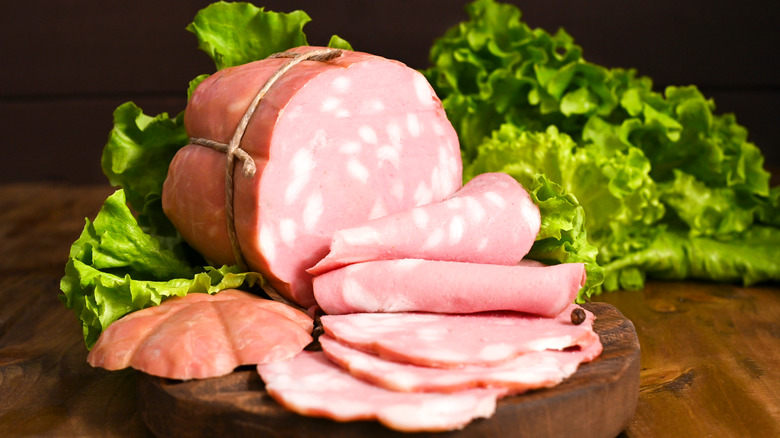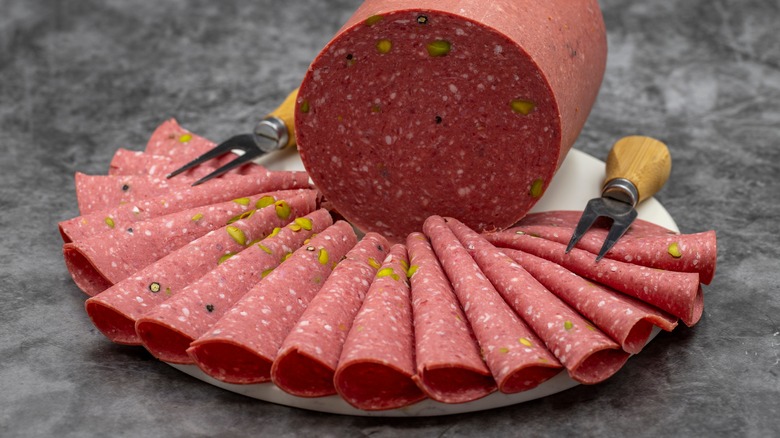What Exactly Is Mortadella And What Is It Made Of?
You'll never find bologna in Bologna. The classic American lunchmeat and the Italian city it's named after are only distantly related. Long before the days of bologna sandwiches and Oscar Mayer jingles, there was mortadella. It's the signature sausage of Bologna and a wildly popular deli item around the world to this day. Mortadella is the predecessor of today's bologna sausage (a.k.a. "baloney"), but it's a far more nuanced product with a rich history behind it.
Traditional Italian mortadella is a steamed sausage made from finely ground pork, blended with bits of pork fat, peppercorns, and oftentimes, pistachios. The fat must come from the pig's neck; it has an exceptionally high melting point, which keeps it solid even after the sausage is cooked. This creates a white speckles throughout the meat, the visual calling card of mortadella.
Mortadella has been made in the region of modern-day Bologna since ancient times. The city's archeological museum houses a stone carving from the Roman era depicting a group of pigs along with a mortar and pestle. It is thought that the name "mortadella" is derived from mortar, the original tool used to pulverize pork into a smooth sausage texture. Another theory suggests that the name comes from "mirto," the Italian for myrtle, as myrtle berries were used to season mortadella before peppercorn became widely accessible. Today, Bologna is still the mortadella capital, but there are many other regional varieties worth trying.
Types of mortadella
By far, the most famous type of mortadella is mortadella Bologna PGI. The letters PGI stand for "protected geographical indication," meaning that a food can only bear that name if it's made within a certain geographical area. The first recipe for Mortadella Bologna appeared in 1644. And in 1661, a local Catholic cardinal issued a declaration standardizing the production of this style of sausage, setting the stage for its modern protected status. Mortadella Bologna can only be made in Bologna, but other regions have spins on the meat that are equally worth your time.
Perhaps the most notable variety of mortadella outside of its hometown is Mortadella di Campotosto, which is made in the province of Campotosto, about five hours south of Bologna. This variety is smoked rather than steamed, and incorporates cloves, cinnamon, and white wine. However, its most distinguishing trait is its fat content. Instead of containing lots of little speckles of pork fat, Mortadella di Campotosto has a single stick of lard running through the center of the sausage. It is considerably smaller than Mortadella Bologna, and the sliced sausage sometimes bears the shape of a four-leaf clover.
Another notable version is mortadella di fegato, meaning "liver mortadella." It's also known as "fideghina" and "Mortadella d'Orta." True to its name, this variety is distinguished by the use of pig's liver in the emulsion. It's made in the regions of Piedmont and Lombardy in the Italian Alps, particularly around Lake Orta.
How to choose and use mortadella
Mortadella is a common offering at deli counters. And at certain specialty stores, you may even be able to find Mortadella Bologna sourced directly from Italy. To make sure you get your hands on high-quality sausage, there are a few things to look out for.
First, the sausage should be quite girthy, with a light pink color. The fat, peppercorns, and optional pistachios should be evenly distributed throughout the meat. If you're buying from a deli counter, ask the butcher if you can sample a bite. The mortadella should have a very smooth mouthfeel. A grainy texture indicates that the sausage was steamed at a higher temperature than it should have been. Flavor-wise, it should be slightly sweet, with just a hint of spice from the peppercorns.
You can use mortadella as you would use any other cold cut, sliced thin on a sandwich or charcuterie board. It's particularly good in a classic New Orleans-style muffuletta. Although it's usually sold in slices, it's common to find cubed mortadella served as an appetizer in Bologna, to be eaten plain. In addition to the typical cold-prep servings, mortadella is also used as a pizza topping or ground and added to minced meat mixtures in meatballs and stuffed pastas.


